As an ecommerce business, you always look to get more website traffic, new shoppers, better customer feedback and obviously, ways to earn more revenue.
The good news–you have numerous ways to generate traffic and sales. From search and social media to email and referrals, there’s no shortage of marketing strategies to implement and test.
But the bad news? There are numerous ways to generic traffic and sales.
Without a coherent and up to date ecommerce marketing strategy, you risk falling into the trap of trying too many things without knowing what works. Before jumping into traffic-generating tactics, you first have to iron out your ecommerce marketing strategy so it’s able to connect to the modern shopper.
Think of the perfect ecommerce marketing strategy having a roadmap to show you who to target, how to engage your audience and how to measure your efforts so you only invest ROI tactics. On top of that, you need to know the recent market changes and what it takes to succeed in online sales for 2019.
To help you get closer to your objectives, check out our five step ecommerce marketing strategy for 2019:
- Step 1: Know Your Audience & Their Problems You Solve
- Step 2: Limit Your Site’s Purchase-Blocking Obstacles
- Step 3: Determine Your Marketing Channels
- Step 4: Execute Your Campaigns & Stay Focused
- Step 5: Measure & Analyze Your Results
Step 1: Know Your Audience & Their Problems You Solve
You can’t have a successful ecommerce marketing strategy if you don’t know who to market. That’s why the first step is to get to know your target audience.
Who do you want to reach with your marketing? What messaging resonates them?
Figuring all that out requires creating buyer personas or avatars of your target customers. Begin by asking questions like “Who do we want to attract to our site?” and “Who are our typical buyers?”
The answers to these questions should give you an initial picture of what your target customer looks like. For example, if you’re a fashion boutique that sells high-end vintage clothing, then one of your ideal audiences could be women in their 30s with disposable income.
https://www.instagram.com/p/BwrgzLxH0sn/
Once you have a general idea of who to target, you’ll need to flesh out your personas and make them more real. You can do that by sticking to a few rules.
Focus on a Single Person for a Persona
Each persona should consist of a single individual. This means when you’re building the profile of your avatar, the details entered should apply to just one person.
Instead of saying your persona includes women who are 30-35 years old, the persona should be a 33-year-old woman earning $75,000+ annually.
https://www.instagram.com/p/BvAAI_xg7dv/
Of course this seems counterintuitive since you’re trying to sell to many people. However, focusing on a single customer allows you to uncover more useful and specific characteristics about the key shoppers that you want to reach.
Doing so makes your message more relevant and compelling.
Give Your Persona a Name & Photo
Naming your persona and adding a visual component makes them tangible. It also helps your entire marketing team understand the demographic more clearly.
The realer an avatar is to you and your team, the easier it is know the potential customer such as their likes, dislikes, hobbies and overall buying process.
Get Very Specific With Your Persona Details
Through audience research, you should uncover demographic and psychographic details about your persona. Use the info you gather to develop a rich profile that answers questions like:
- How old is your persona?
- Where do they live?
- How much do they make per year?
- Are they married?
- Do they have kids?
- What do they spend time doing?
- What problems or issues puts them in your store?
Here’s an example of what a persona page might look like:
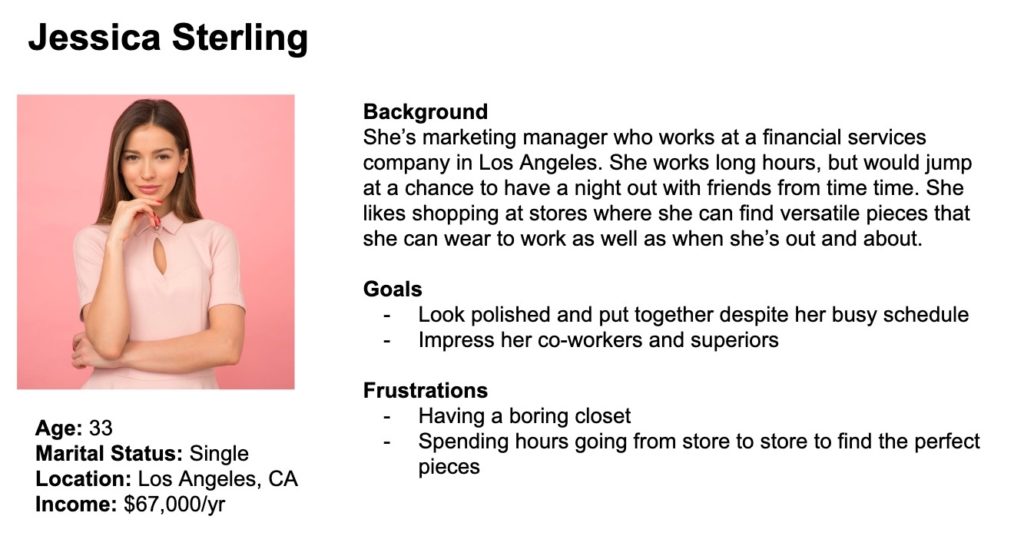
Consider doing something similar with your persona profile. Create a page for them, give them a name and populate their profile with specific details. This will allow you to get a more accurate target audience.
Step 2: Limit Purchase-Blocking Obstacles on Your Website
One of the key objectives of every ecommerce marketing strategy is to drive traffic to the website. As an online retailer or even brand, you want your audience to go to the exact spot where they can buy your products.
That’s why your website has to be easy to navigate and limits the hurdles to get checked out. The last thing you want is to have a smashing marketing campaign that persuades people to check out your brand, only for them to bounce when they reach your website.
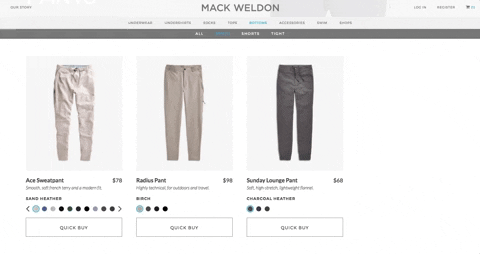
Check out this example from Mack Weldon, a mens direct to consumer online clothing store. Their site’s “Quick Buy” functionality lets you choose a color, size and presents the checkout cart all on one window before even getting into the product page.
There isn’t a one-size-fits-all strategy for creating a winning site, but it always helps to make it easy and simple to checkout. And to help you improve your website, here are some general best practices:
Make Sure Your Site Speaks to Your Audience
At this point, you’ve done a lot of research on your target customers. Put all the information into good use by making sure that all the elements of your webpages—from the design and layout to the copy and images—speak to your key audience.
Doing that means using content and imagery with which your target customers can identify. For example, Forever 21, which caters to young girls looking for great deals, uses web copy and imagery to appeal to its audience.
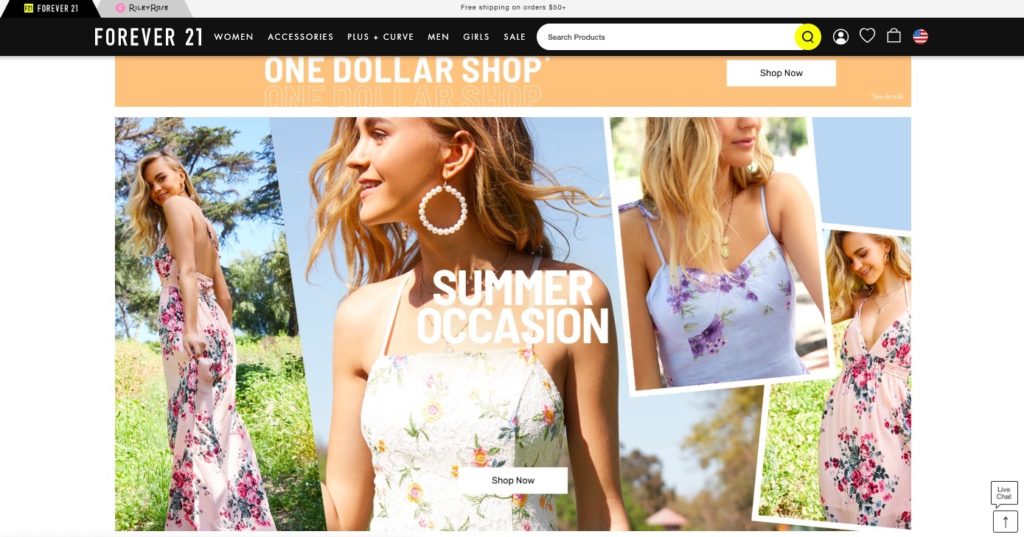
Forever 21’s website has a big, bold design that promotes deals like its One Dollar Shop. The brand also hires models that reflect the types of customers it wants to reach.
The company is constantly trying to connect with its audience by promoting brand advocates and its biggest fans. This helps build a better community between the shopper and retailer.
Promote Trust
Shoppers today are certainly more comfortable buying stuff online, but some still experience uncertainty when making an ecommerce purchase. That’s why it’s important to create a site that instills trust and credibility.
Your site should make customers feel confident about their purchase decisions. You can do that through authentic product reviews and user-generated content that shows shoppers what real customers are saying about your items.

Invest in a Mobile-Friendly Site
Mobile has overtook desktop when it comes to sites visits. A study by Perficient Digital found that in 2018, 58% of site visits came from mobile devices, and mobile made up 42% of total time spent online.
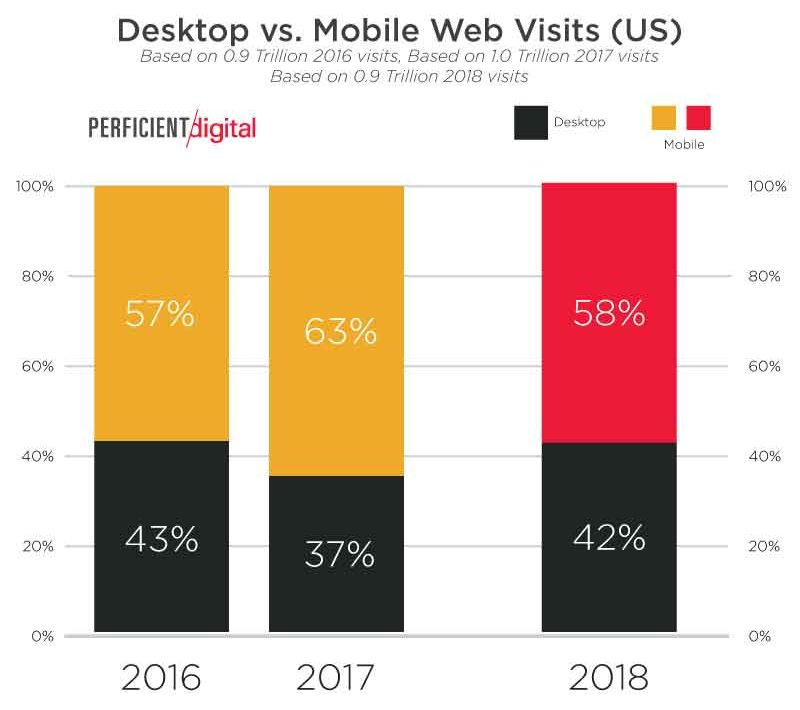
People clearly love browsing on their mobile devices, so if your site doesn’t look or function well on the small screen, you’re in trouble.
Take the necessary steps to ensure that your site is mobile friendly. At the very least, see to it that you’re using a responsive mobile design. And if you have the resources to do so, consider implementing a mobile-first site experience.
There’s also the issue of speed. Mobile site load times are generally slower than desktop, so you’ll need to make mobile-specific adjustments to ensure that smartphone and tablet users can load your site quickly.
Speaking of speed…
Always Find Ways to Speed Up Your Website
Poor website load times is one of the top reasons that visitors leave an ecommerce site. According to data from Google, when a page’s load time goes from 1 to 10 seconds, the likelihood of a mobile user bouncing increases by a whopping 123%.
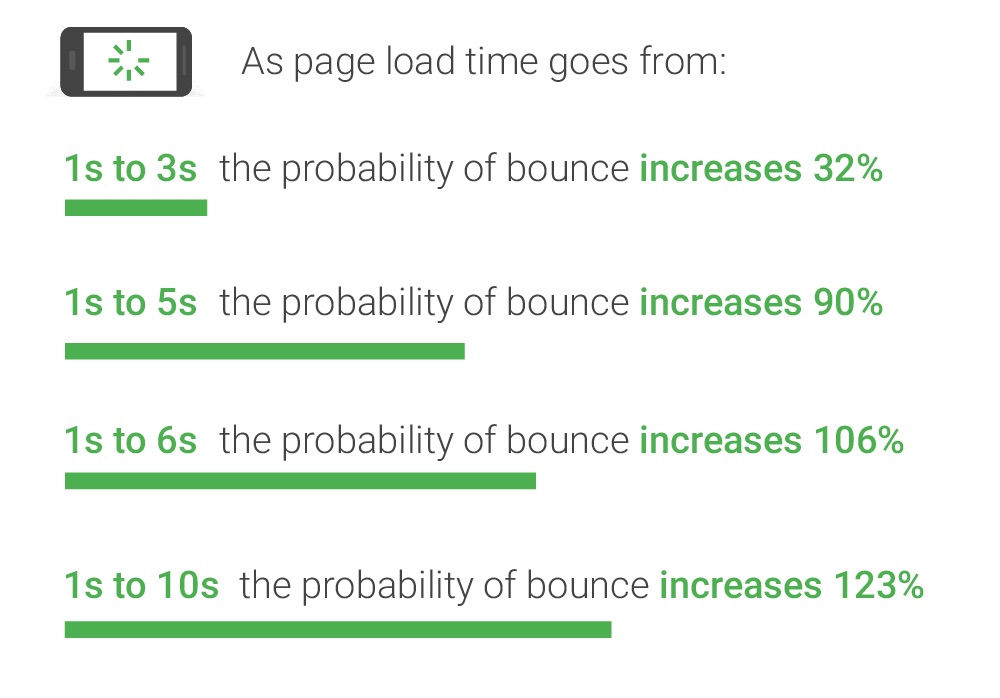
For your ecommerce marketing strategy, you have to include ways to improve site speeds. As Neil Patel points out, 40% of users leave a website that takes more than 3 seconds to load and 52% of online shoppers said that speedy load times are important to their loyalty to a site.
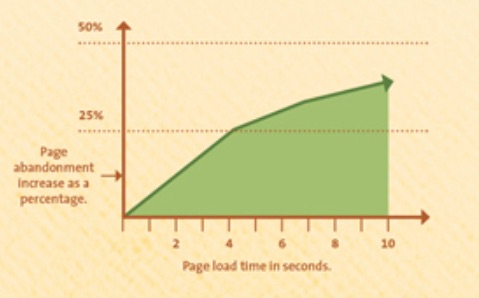
One way brands and retailers are improving their site speeds is by moving to ratings and reviews providers that use 100% Javascript software on their pages. PowerReviews worked hard to ensure our software was as fast as possible and would not alter page load times being on ecommerce sites.
In fact, we reduced our JavaScript size by up to 26% on product detail pages, which makes PowerReviews more than 40% smaller than some of our major competitors!
How to Improve Page Load Speeds
Speed is paramount in online commerce, so here’s a few other ways to improve your page load times:
- Avoid Overly-Large Visuals & Files: Visuals are essential in ecommerce, but using images with large file sizes can slow down a website. Avoid using larger-than-necessary images by shrinking their file size through a tool like Resize Image.
- Choose a More Optimal File Type: Additionally when it comes to image files, converting an image file from PNG to JPG compresses the image without compromising a lot in terms of quality.
- Prevent Excessive Redirects or 301s: Redirects tell a browser that the webpage you’re trying to visit now goes to another URL. This happens often and seamlessly without customers knowing. However, loading redirect URLs adds another step, which slows down sites. It also makes it more difficult for search engines to rank or read your page.
- Limit Unnecessary Plugins or Tools: Plugins can add to your site’s load time, so remove anything that isn’t necessary to each page. Again, it’s critical to know what platforms take up the most and least amount of space on your site.
- Know What Slows You Down: Each web property is different, so analyze the performance of your website to identify the issues slowing you down. Google’s own Page Insights tool is a good place to start. It gives your site a speed score, runs diagnostics and surfaces opportunities to speed it up.
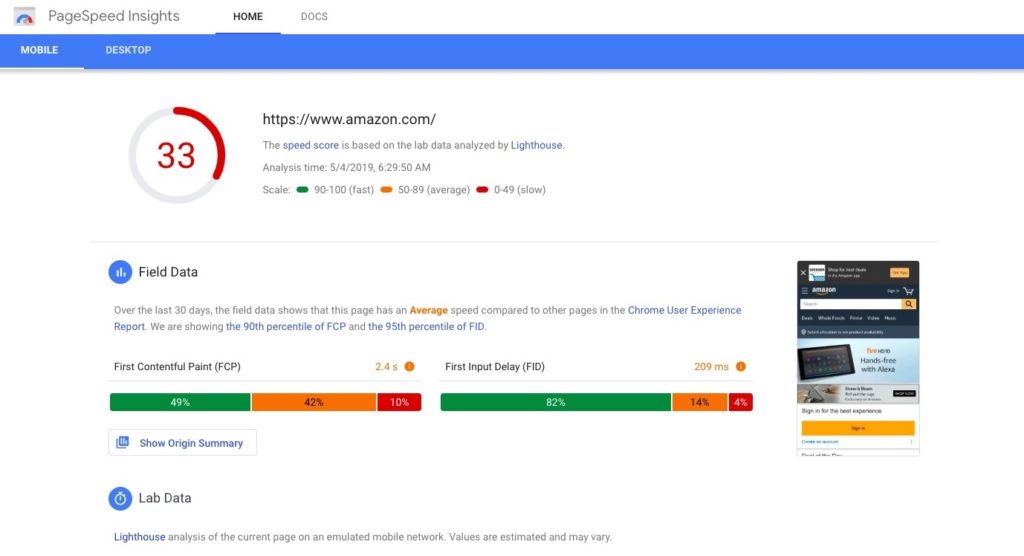
Step 3: Determine Your Marketing Channels & Tactics
Is your website in top shape? Good. Now, let’s talk about the marketing channels and tactics you can use to drive traffic to it.
Social Media
People spend hours on social media daily, which makes social networks effective platforms for getting in front of your potential shoppers. There are plenty of ways to implement social media marketing, but in general, your efforts would fall into one of two buckets:
Organic Social Media Marketing
Organic social media marketing is all about growing your following and reach through natural ways. You do this by posting likeable and share-worthy content that appeals to your audience.
Taking advantage of features like hashtags and mentions to get your content in front of a wider audience. Check out this post from Fatty Sundays.
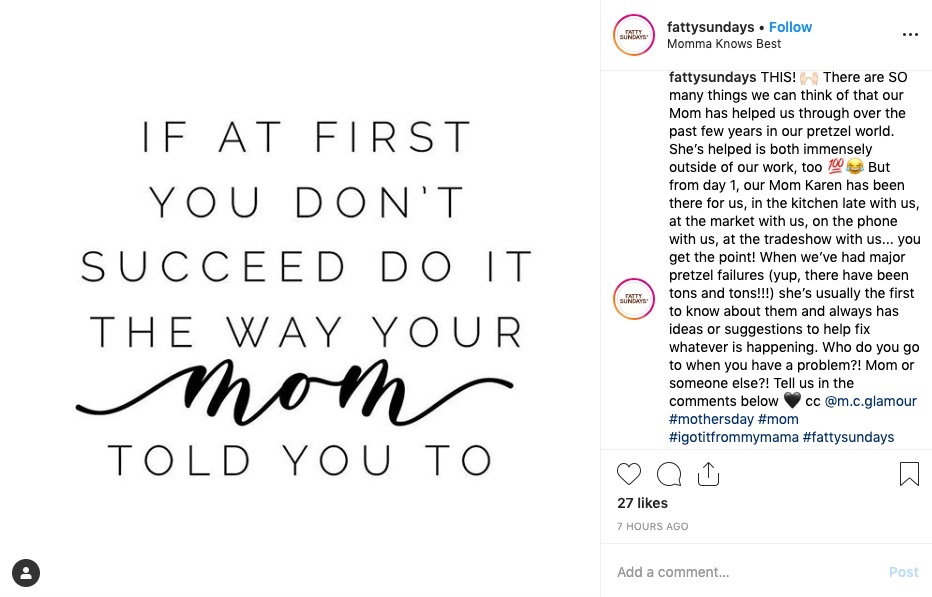
Aside from being witty and timely, the post contains popular hashtags. Fatty Sundays also tagged and mentioned the source of the quote.
Paid Social Media Marketing
Want to pay for more engagement? Paid social media marketing campaigns allow you to extend the reach of your content. Facebook, Instagram and Twitter have native tools that get your posts in feeds of users who aren’t already following your brand.
Whether you want to promote a new product or retarget previous users, there are several social ad tools to check out. For instance, promote a specific product page or offer a deal like Firstleaf in this ad.
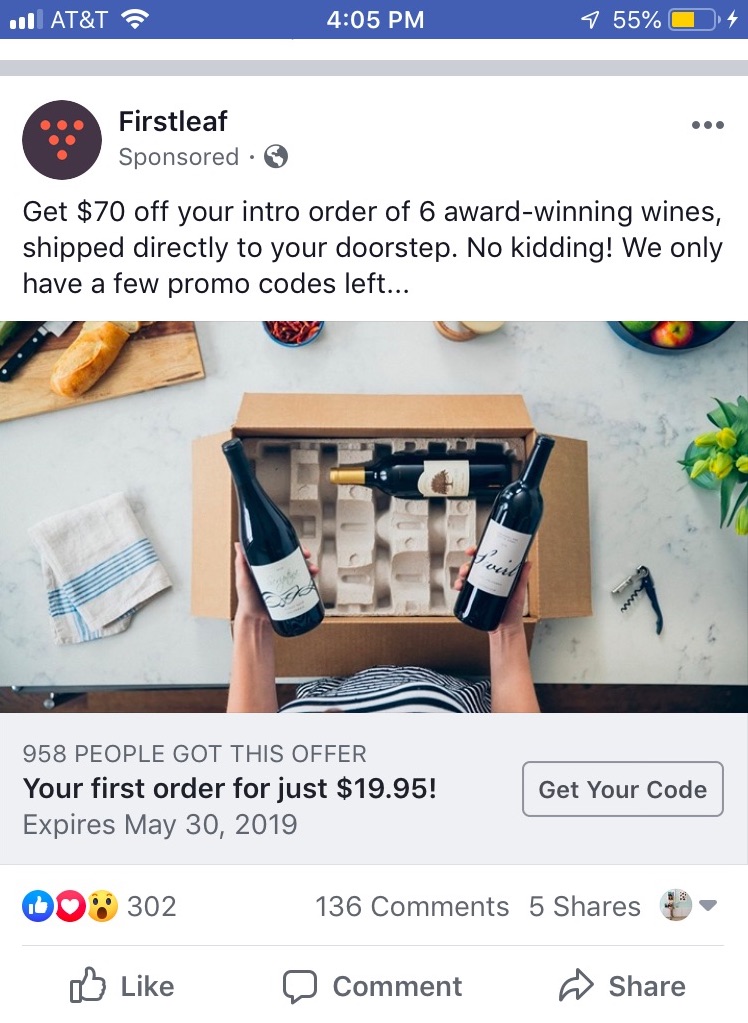
Or, you can promote a collection of products by using a carousel ad. Side note: it’s smart to know the various Facebook or Instagram sizes for its carousel images and videos. It’s all about ensuring your content is promoted at the highest quality possible so it fits perfectly into the ad or organic post.

No matter what type of tools you decide to use, keep in mind that the best social media marketing campaigns usually have a mix of organic and paid components. Organic brand reach has decreased significantly over the last few years. So as you continue creating engaging content for your followers, you also need to put money behind your efforts to reach more people.
Email Marketing
Social media marketing can do wonders, but don’t rely on it alone to reach your audience. Here’s why: social platforms essentially control the reach and distribution of your posts. A single algorithmic change can diminish the performance of your content.
With email marketing, you have more control over the distribution of your content. The email addresses of your subscribers live in your database, which means you have a better handle of when and how to get in touch with them.
Any good email marketing strategy starts with a compelling offer to get people to hand over the email address. Here’s one from Amika, which gives people a 15% discount in exchange for their email.
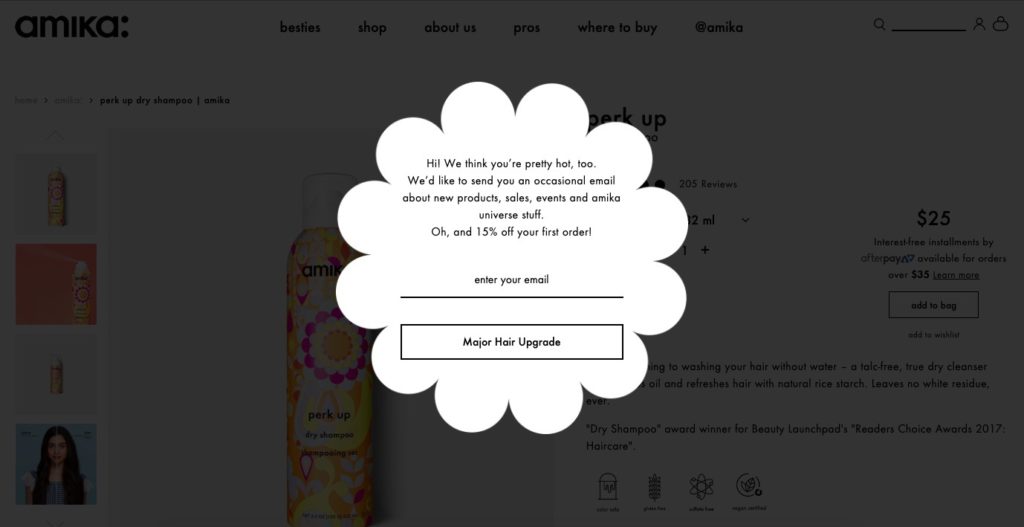
From there, you can craft an email marketing calendar that has a healthy mix of engaging content (i.e., promotions, company news, editorial content) that drives traffic back to your site.
Influencer Marketing
According to MuseFind, a whopping 92% of consumers trust influencers more than traditional celebrities. Influencers clearly have a lot of pull with consumers, which is why it makes sense for brands to engage them.
Influencer marketing comes in many forms but it typically involves building relationships with social media personalities who can influence your target audience.
Think about the people your customers follow on social media. Aside from their friends and family, who are the individuals that they look up to? Whose content do they enjoy consuming?
Once you’ve identified the right people, reach out and see if you can sponsor their content. In some cases, doing this means letting the influencer publish posts featuring your products. Have a look at this example from Wil De Beast, a GNC Canada Ambassador:
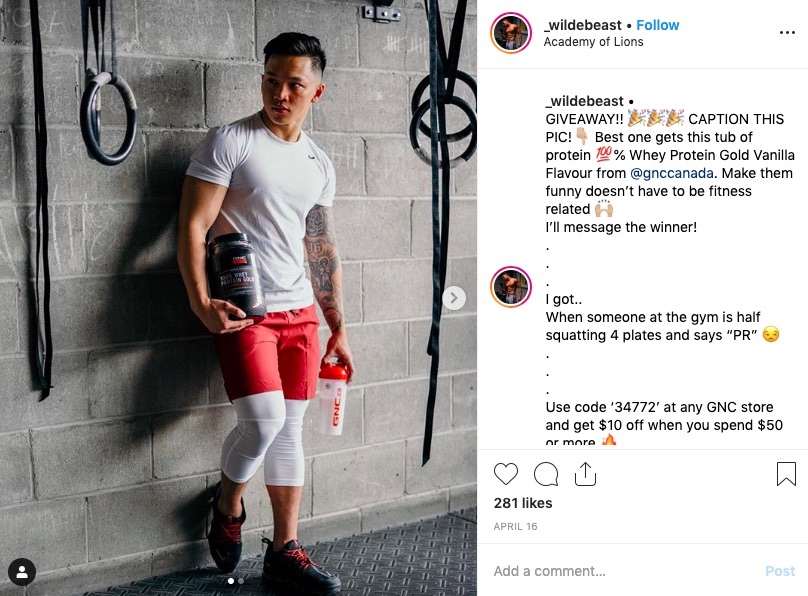
In other instances, brands co-create content with the influencer. Rather than an obvious ad, the brand’s product appears as a natural part of the influencer’s story.
You can see this in action the following short film by YouTube stars Wong Fu Productions, which they did in collaboration with homeware retailer Simplehuman.
The nature of your relationship depends on the influencer. Whoever you decide to work with, though, choose to align yourself with individuals who fit your brand’s values.
Affiliate Marketing
Already have an active customer base? Set up an affiliate agreement where they’re rewarded every time they successfully refer someone to your brand.
That reward be a commission, free products, or a discount. There’s no one best way to do it, as the best affiliate marketing structure depends on your business model.
Meal prep company Freshly, for instance, implements a “Give $40, Get $40” referral program to encourage its members to share the service with their friends.
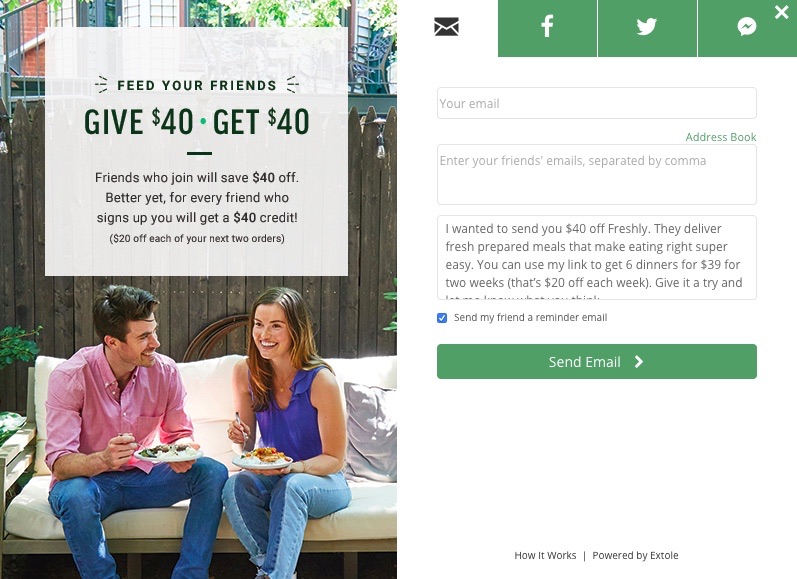
Search Engine Optimization
Search engine optimization (SEO) is a wide topic and it covers a variety of tasks including:
- Keyword research
- Content creation
- Site mapping
- Website performance optimization
- URL optimization
It’s incredibly powerful to get your brand in front of people who are actively searching for products you sell. That’s why when implemented correctly, SEO for ecommerce is profitable marketing strategy.
Do note that the keyword here is “correctly.” Engaging in unethical or black hat SEO tactics can lead to penalties from search engines, completely derailing your ecommerce site.
Be sure to stay on Google’s good graces when running an SEO strategy or better yet, hire an experienced professional or agency with a proven track record.
Search Ads
SEO is effective, but it takes time and continuous effort to make it to the top of search engine results pages. If you’re looking for a shortcut to the top of SERPs, search ads are the way to go.
The most popular types of search ads in ecommerce are Google AdWords and Google Shopping ads, or Product Listing Ads.
- Google Adwords: These are text-based ads that appear on top of organic search results. Unlike social media ads which target users based on their demographics AdWords target search queries. So, if you’re an online retailer that sells teas and tea accessories, you could use AdWords to target users searching for things like “tea infusers” or “loose tea leaves.”
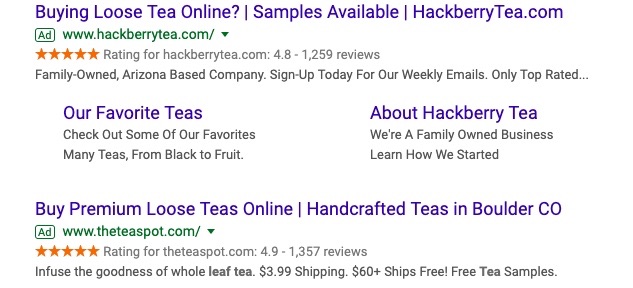
- Google Shopping Ads: Like AdWords, Google Shopping Ads appear above the organic search results. Unlike AdWords, Shopping ads are image-based and they pull from the advertiser’s online inventory. Sign up for a Merchant Center account and upload your products into a feed. Then start creating shopping campaigns to get products appearing in relevant searches.
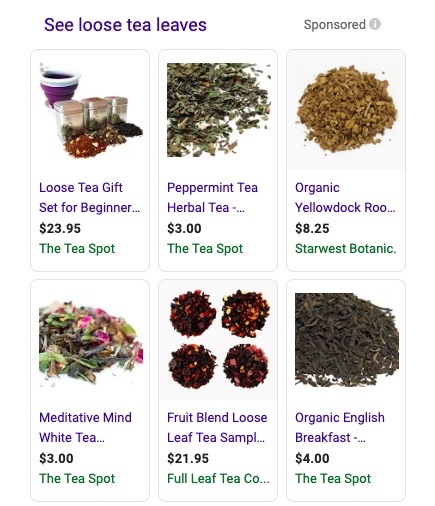
Content Marketing
Marketing doesn’t always have to involve plugging your products. In many cases, creating high-quality content can attract the right traffic—and ultimately, the right customers.
A great example of a brand investing in content marketing is Dollar Shave Club. DSC regularly publishes informative and entertaining content about grooming and lifestyle, which perfectly aligns with its brand.
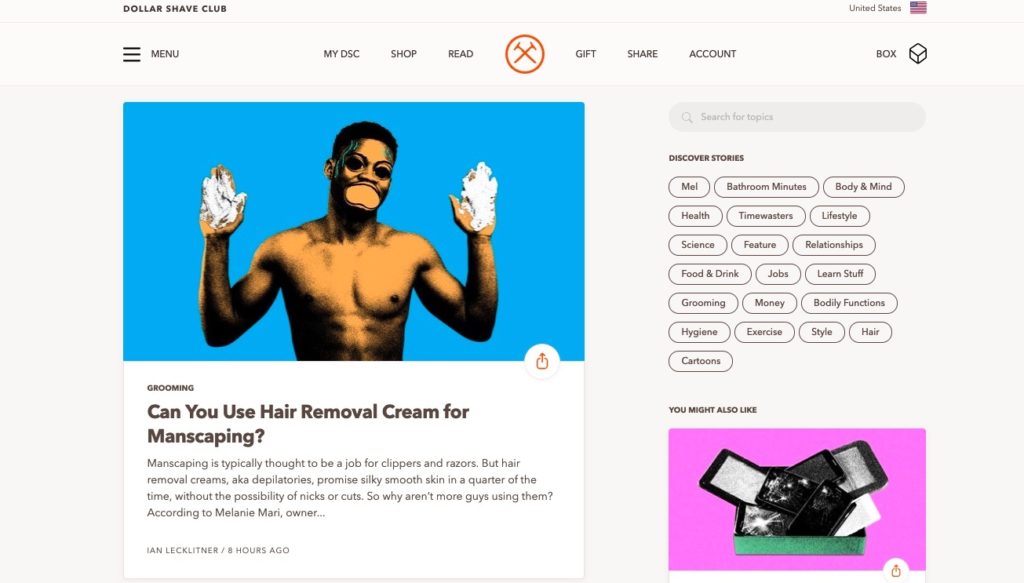
Offline Marketing
It may be against your instincts to have an offline marketing strategy if you try to drive online traffic. However, a strong physical presence benefits your brand in a number of ways.
For starters, it gives you more credibility. Anyone can build an ecommerce store, but nothing builds your “retail cred” more than having a shop in the real world.
An offline ecommerce marketing strategy also boosts online sales. Research by the International Council of Shopping Centers (ICSC) found opening retail stores increases an ecommerce business’s site traffic by 37%.
Now, you don’t necessarily have to build fully-fledged brick-and-mortar stores to have an offline presence. Many ecommerce brands are starting small by establishing pop-up shops in select markets.
The online pure play Brandless did just that last year. The company opened a pop-up shop in Los Angeles, where people get to know the brand and its products. What’s cool about the initiative is that Brandless used it to drive online sales.
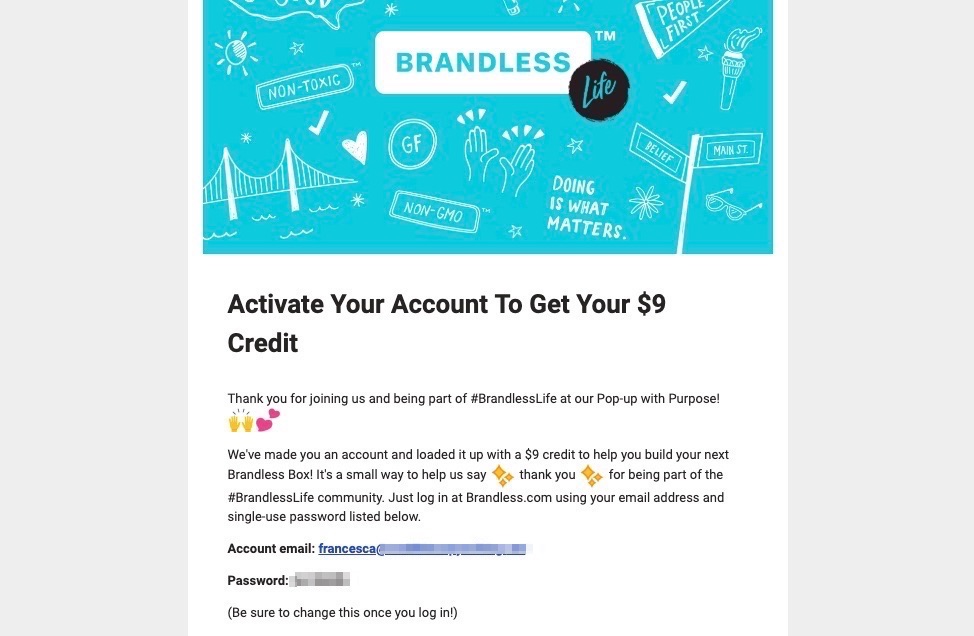
A few days after the pop-up event, Brandless emailed attendees with a $9 credit that they can use towards their first purchase on the site.
Step 4: Execute Your Campaigns & Stay Focused on Goals
You’ve done your audience research, tightened up your website and identified the best marketing channels and tactics for your business. The next step is executing your campaigns.
The specific best practices around campaign execution will depend on your marketing channels, but here are some general things to consider:
Keep Your Team in Sync
If your campaign has several moving parts, you need to ensure that everyone involved is on the same page. You can do this by:
- Appointing a Project Owner: Have one person “own” the campaign. They will oversee its various components and will serve as the go-to person for the campaign. When there’s a project owner, those working on the campaign know immediately who to turn to for questions and concerns, leading to fewer miscommunications.
- Use an Efficient Communication Channel: One of the best ways to keep your team in sync is to have a shared platform on which people can post updates or raise issues. A project-specific forum or chat room (e.g. Slack channel) where all the stakeholders are present can serve as an effective solution for this.
We're deepening the way tools you already use every day, like email, calendar, calls and files, integrate with Slack. With tools like our new apps for email and calendars, information flows into and out of Slack, removing friction from your work day. #SlackFrontiers pic.twitter.com/uR62OS6LwF
— Slack (@SlackHQ) April 24, 2019
Set Your KPIs & Metrics
Remember the famous John Wanamaker quote?
“Half the money I spend on advertising is wasted; the trouble is I don’t know which half.”
This line gets passed around in advertising and marketing circles But to this day, countless marketers fall into the trap of trying new ecommerce marketing strategies and tactics without properly measuring and attributing results.
Avoid this with clear campaigns KPIs. Ask yourself what success looks like and determine the metrics by which your campaign’s performance will be measured.
Get the Timing Right
Even the best campaigns fall flat if they’re executed at the wrong time. Make timing an important consideration for your marketing campaigns to maximize their impact.
Keep a marketing calendar that lists all important events and occasions throughout the year. Go beyond the big holidays and pay attention to big pop culture events.

Need inspiration on how to do this right? Check out this campaign from Alex + Ani. Launched in May 2019, the campaign centered on two hot and timely themes: Mother’s Day and Game of Thrones.
Step 5: Measure & Analyze Your Results (Success & Failures)
Analytics is a critical component of any ecommerce marketing strategy. With the right data, you determine which components of your strategy work and what doesn’t. This lets you replicate the positive results and improve on things that not going well.
The key to nailing the analytics side of things is proper attribution. By assigning a tracking component to each initiative, you can trace the results to specific campaigns or efforts.
The right tracking methods depend on what you do. If you market on Facebook, take advantage of Facebook’s ad pixel. If you’re running affiliate campaigns, set up your referral links correctly you can attribute sales to the right sources.
Analyze Your Product Insights Thoroughly
You likely have a mecca of product insights in front you–but are you even using this content to make better product decisions?
Ratings and reviews content helps brands and retailers investigate, detail and improve product launches or faulty occurrences with items in general. That’s why we made Product Pulse.

With the help of Product Pulse, you can dig into the hundreds or thousands of reviews to find common customer sentiment analysis data. For example, it’s easy to see the most popular adjectives for an item at the product level.
You might think it’d be just as easy to dig through reviews and find this data, but we’ve done it, and it’s just not true. It takes a ton of manpower and hours to dig, pull commonalities and even avoid unintended biases with your results.
Or you could use Product Pulse to pull reports on individual products in minutes.
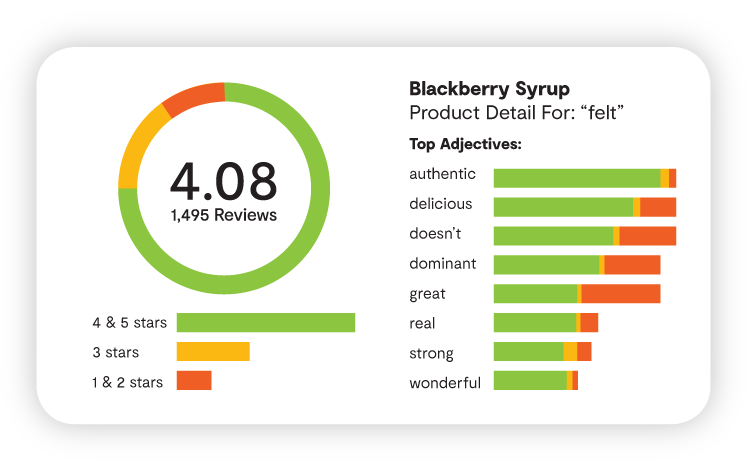
Want to see it in action? Request a demo today to test drive Product Pulse yourself!
Get a Qualitative View of Your Ecommerce Marketing Strategy
It’s important to note that measuring and analyzing your activities isn’t just about the numbers. Produce a more qualitative view of how your ecommerce marketing strategy operates and works.
You can do this catching up with your team on a regular and per-project basis. Let’s say you just finished running a major marketing campaign.
After wrapping up, get the project’s stakeholders together and discuss the results. What went right? What didn’t? How can you improve going forward?
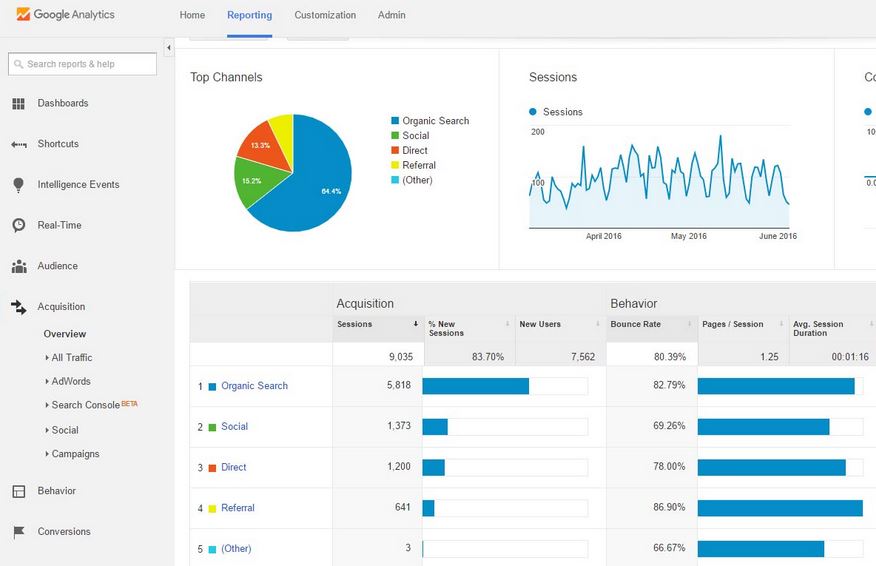
Combined with web analytics data, qualitative insights will give you the full picture, which in turn can help you take your ecommerce marketing strategy to the next level.
And there you have it! The ultimate guide to running a successful ecommerce marketing strategy. We’ve covered a lot of ground in this piece and we hope it gives you a clear picture of how to best market you store.
Good luck!




